House fires are unpredictable and can have devastating consequences. Being prepared is key to safeguarding your loved ones and property. At PuroClean of Denver, we prioritize fire safety and preparedness. In this article, we will explore essential steps to ensure you are ready in case of a house fire, from prevention to post-fire protocols.
Installing Early-Detection Devices
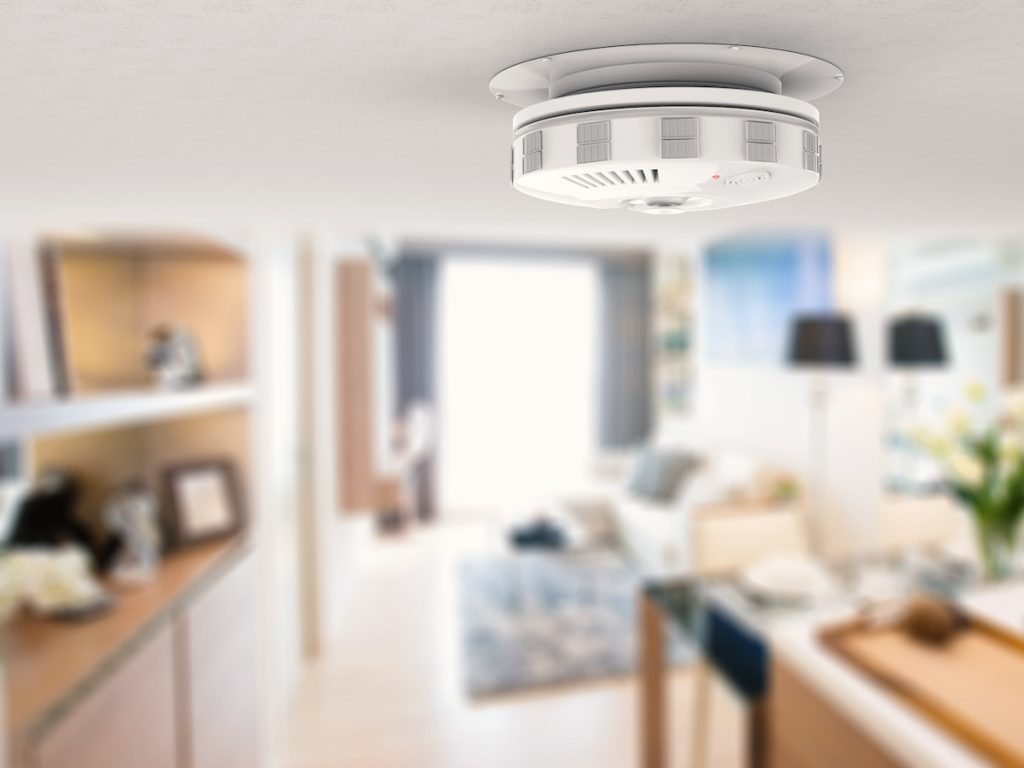
Smoke detectors are essential devices that serve as the first line of defense against house fires. Having an adequate number of smoke detectors installed throughout your home is crucial for early fire detection. It is recommended to have smoke alarms on every level of your home, including inside and outside sleeping areas. For optimal safety, interconnected smoke alarms that communicate with each other and sound collectively in case of detection are highly effective in alerting all occupants simultaneously.
The placement of smoke detectors plays a significant role in their efficacy. Smoke alarms should be installed on the ceiling or high on the wall, as smoke rises and these locations provide the earliest detection. It’s advisable to avoid placing smoke detectors near windows, doors, or ducts, as airflow can affect their operation. Additionally, it’s essential to test smoke alarms monthly and replace batteries at least once a year to ensure they are functioning correctly. Unfortunately, many people remove batteries from smoke detectors due to nuisance alarms or low battery chirping, leaving them vulnerable to the devastating consequences of a fire without early warning.
Removing batteries from smoke detectors, whether intentionally or unintentionally, can have severe implications. In the event of a fire, a non-functional smoke alarm significantly delays the detection of smoke and flames, putting lives and property at risk. Studies have shown that a considerable number of fire-related deaths occur in homes without working smoke detectors or with removed batteries. Prioritizing the maintenance and proper functioning of smoke alarms is paramount to ensuring the safety of your household and providing valuable time for evacuation in case of a fire emergency.
Creating a Fire Emergency Escape Plan
Creating a fire emergency escape plan is crucial for every household to ensure the safety of all occupants in the event of a fire. Begin by checking each sleeping area for at least two exit points, such as doors and windows, and ensure they are easily accessible. Map out primary and alternative escape routes from each room and designate a meeting place outside, a safe distance from the home, where all family members can gather after evacuating.
Practice your escape plan regularly with all household members to familiarize everyone with the routes and procedures. During drills, emphasize staying low to avoid smoke inhalation, as smoke rises during fires. Before opening doors, check for heat or smoke by using the back of your hand. If a door is hot, do not open it, and use an alternate route. Close doors behind you as you exit to slow down the spread of fire and smoke throughout the home. Windows can be used as alternative escape routes if necessary.
For occupants of multi-level buildings, it’s essential to have escape ladders or other evacuation devices available in upper-level rooms. Familiarize yourself with the building’s evacuation plan and designated fire exits. In high-rise buildings, always use stairwells for evacuation rather than elevators, which may malfunction during a fire. Consider designating a buddy system for elderly family members or young children who may need assistance evacuating. Being prepared and proactive in planning for emergencies can make a significant difference in ensuring the safety and well-being of everyone in your household.
After a House Fire
After a house fire is put out, the smoke has cleared, the fire department is gone, you are left with a disaster on your hands. In the aftermath of a fire–no matter how big or small–it’s imperative to know what to do and what to avoid doing.
In the first few hours and days after a fire, your home will likely suffer from extensive fire and smoke damage, as well as water damage. During this time, it’s best to hire a professional restoration company to thoroughly handle the restoration process. You certainly don’t want to cause further damage or worsen the already-devastating situation! PuroClean can assist with restoring salvageable damaged possessions and getting your property back to pre-loss condition.
While we want you to leave the restoration services to us, there are some things you can do right away following a house fire. This blog offers a house fire checklist with suggestions for what to attempt immediately after a fire and what to avoid.
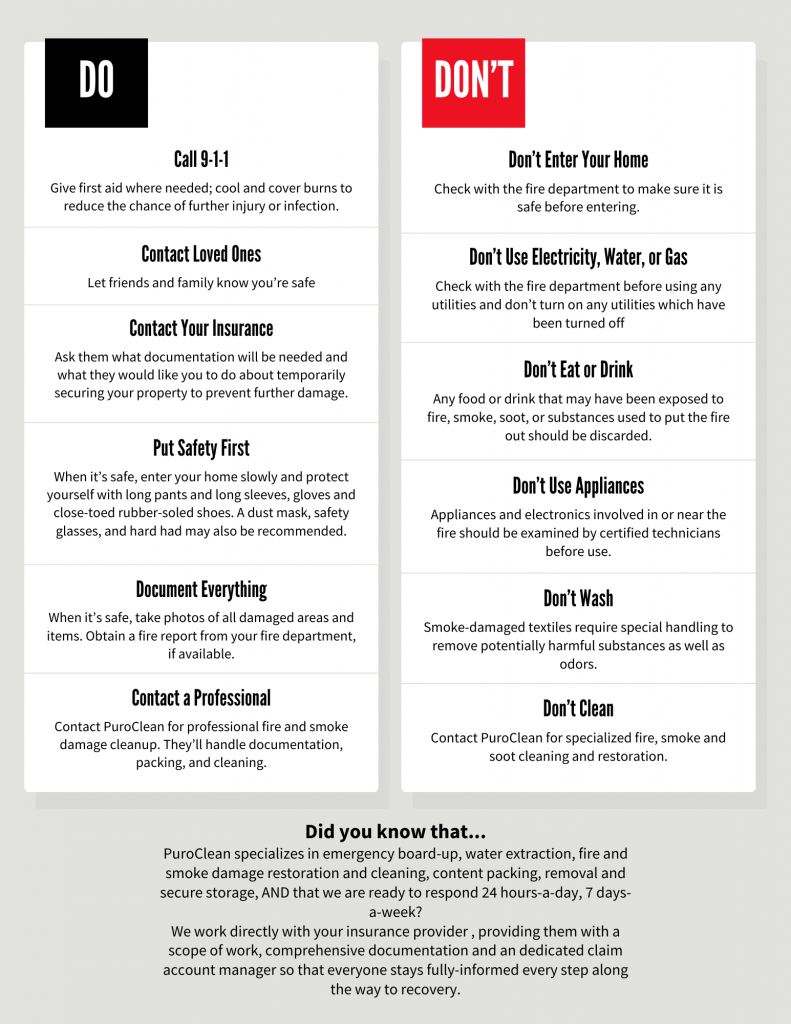
7 Things To Do After a House Fire
- Call 9-1-1: Contact emergency services if not already done to report the fire and seek any necessary medical assistance.
- Provide First Aid: Offer first aid where needed, particularly for burns. Cool and cover burns to reduce the risk of further injury or infection.
- Inform Loved Ones: Reach out to friends and family to let them know you are safe and update them on the situation.
- Contact Your Insurance Company: Inform your insurance provider about the fire. Inquire about the required documentation and securing your property to prevent additional damage.
- Prioritize Safety: When permitted, cautiously enter your home wearing protective gear such as long pants, long sleeves, gloves, and closed-toed rubber-soled shoes. Consider using a mask, safety glasses, and a hard hat for added protection.
- Document Damage: Take photographs of all affected areas and items once it’s safe to do so. Obtain a fire report from the fire department if available.
- Seek Professional Assistance: Reach out to PuroClean for expert fire and smoke damage cleanup services. Their team will manage documentation, packing, and thorough cleaning to facilitate the restoration process.
6 Things NOT To Do After a Fire
- Do Not Enter Your Home: Wait for confirmation from the fire department that it is safe to re-enter your home. Entering prematurely can pose risks due to structural damage or lingering hazards.
- Avoid Using Utilities: Refrain from using electricity, water, or gas until they have been inspected by professionals or approved by the fire department to prevent potential accidents or further damage.
- Do Not Consume Food or Beverages: Discard any food or drinks that may have been exposed to fire, smoke, soot, or firefighting chemicals as they could be contaminated and unsafe for consumption.
- Avoid Using Appliances: Have appliances and electronics near or involved in the fire inspected by certified technicians before attempting to use them to prevent electrical hazards or malfunctions.
- Refrain from Washing Textiles: Smoke-damaged textiles require specialized cleaning methods to eliminate harmful substances and odors effectively. Avoid washing them yourself to prevent setting in odors or causing further damage.
- Do Not Attempt Cleaning: Resist the urge to clean up fire, smoke, or soot residues on your own. Contact PuroClean for professional fire, smoke, and soot cleaning and restoration services to ensure thorough and safe cleanup without risking health or property damage.
Many states have provisions for financial assistance to individuals as a result of a catastrophe. Local disaster relief services may be able to help after the fire. Check with your local disaster relief agency or American Red Cross to learn more.
House Fire Statistics in the U.S.
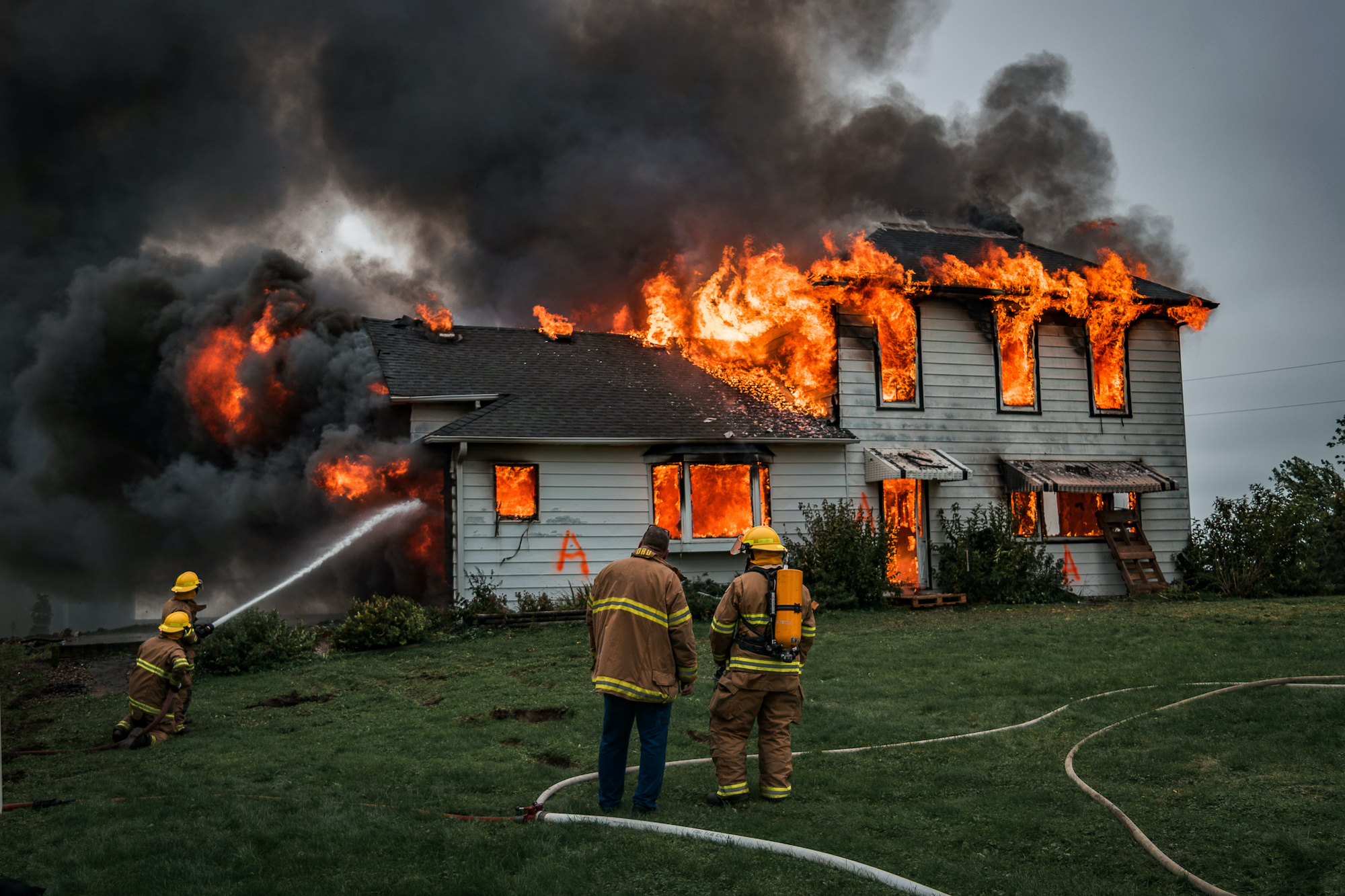
House fires remain a significant concern in the United States, with a home fire reported every 88 seconds and a tragic home fire death occurring approximately every 3 hours and 14 minutes. Homes account for a staggering 96% of all residential structure fires, highlighting the importance of fire safety measures within residential settings. The average monetary loss per structure fire is estimated to be around $28,000, a figure that has been on the rise in recent years, underlining the financial impact of these devastating incidents.
Statistics reveal that cooking stands as the leading cause of house fires, emphasizing the importance of safe cooking practices and vigilance in the kitchen. Conversely, smoking materials pose a higher risk in terms of fire-related deaths, underscoring the need for proper disposal and handling of smoking products. Home fires are more prevalent during the colder months, from November to March, with nearly half of all home fire deaths occurring during the night, between 11 PM and 7 AM, when occupants are likely asleep and less alert to potential dangers.
A concerning fact is that 68% of all home fire deaths and injuries happen in high-risk areas such as the kitchen, living room, or a bedroom, highlighting the importance of fire prevention measures in these commonly used spaces. These statistics serve as a stark reminder of the critical need for fire safety awareness, preparedness, and proactive measures to reduce the incidence of house fires and minimize the associated risks to life and property.

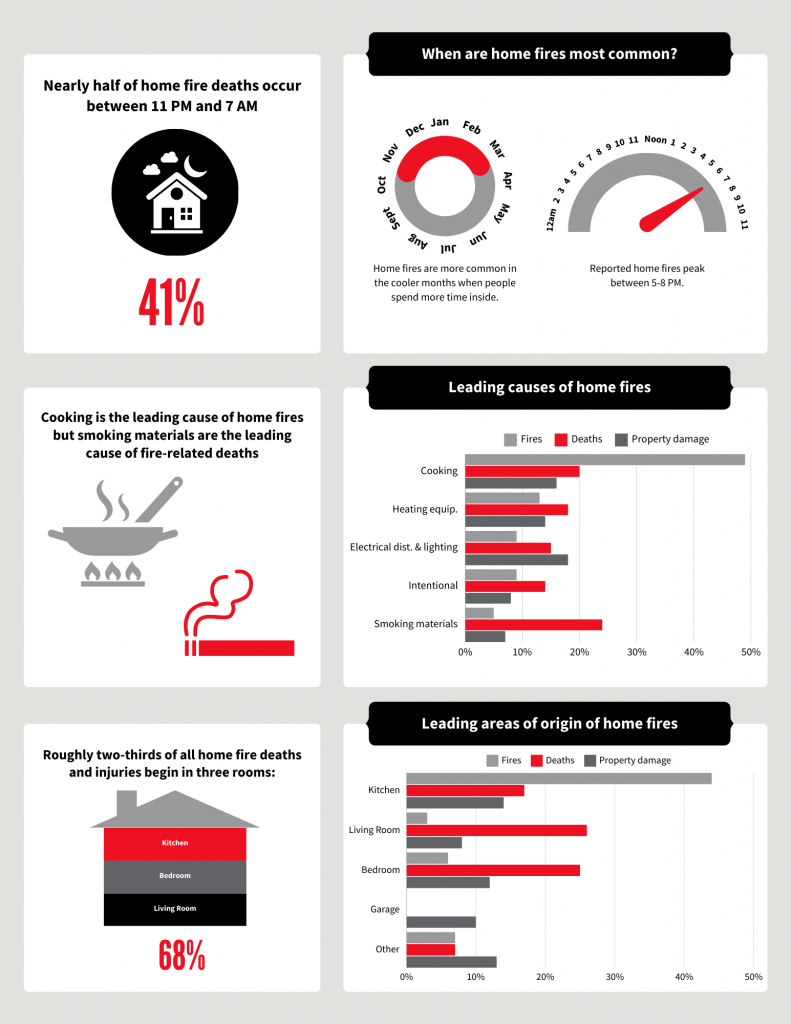
For more resources on fire emergency preparedness, visit:
- American Red Cross – Home Fire Safety
- National Fire Protection Association (NFPA) – Fire Prevention Week
- NFPA – Fire Escape Planning
- Ready.gov – Fire Safety
- Ready.gov – Fire Escape Plan
- USFA.FEMA.gov – Fire Safety Checklist
Don’t wait until it’s too late. Contact PuroClean of Denver today for professional fire and smoke damage restoration services. Stay prepared, stay safe!


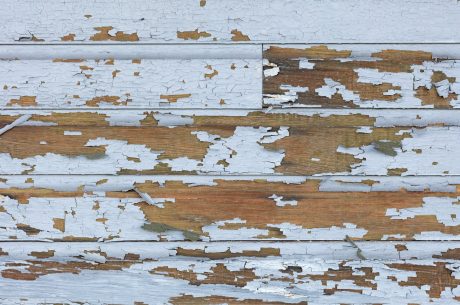
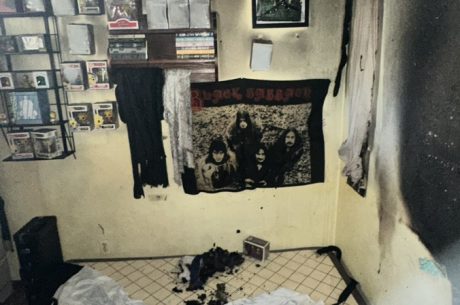

 PuroClean of Central Denver
PuroClean of Central Denver